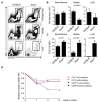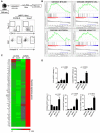Zbtb1 prevents default myeloid differentiation of lymphoid-primed multipotent progenitors
- PMID: 27542215
- PMCID: PMC5312274
- DOI: 10.18632/oncotarget.11356
Zbtb1 prevents default myeloid differentiation of lymphoid-primed multipotent progenitors
Abstract
Zbtb1 is a transcription factor that prevents DNA damage and p53-mediated apoptosis in replicating immune progenitors, affecting lymphoid as well as myeloid development when hematopoietic progenitors are in competition in mixed bone marrow chimeras. However, Zbtb1-deficient mice do not have an apparent myeloid deficiency. We report here that Zbtb1-deficient lymphoid-primed multipotent progenitors (LMPPs) are biased to develop towards the myeloid fate in detriment of lymphoid development, contributing to the apparent unaffected myeloid development. Zbtb1 expression was maintained during lymphoid development of LMPP cells but downregulated during myeloid development. Deficiency of Zbtb1 in LMPP cells was sufficient to direct a myeloid fate in lymphoid-inducing conditions and in the absence of myeloid cytokines as shown by upregulation of a myeloid gene signature and the generation of myeloid cells in vitro. Finally, biased myeloid differentiation of Zbtb1-deficient LMPP cells was not due to increased p53-dependent apoptosis as it was not reverted by transgenic Bcl2 expression or p53 deficiency. Altogether, our results show that Zbtb1 expression prevents activation of a default myeloid program in LMPP cells, ensuring the generation of lymphoid cells.
Keywords: Immune response; Immunity; Immunology and Microbiology Section; Zbtb1; development; differentiation; lymphoid; myeloid.
Conflict of interest statement
The authors declare no competing conflicts of interest.
Figures




Similar articles
-
Zbtb1 Safeguards Genome Integrity and Prevents p53-Mediated Apoptosis in Proliferating Lymphoid Progenitors.J Immunol. 2016 Aug 15;197(4):1199-211. doi: 10.4049/jimmunol.1600013. Epub 2016 Jul 8. J Immunol. 2016. PMID: 27402700 Free PMC article.
-
Pbx1 restrains myeloid maturation while preserving lymphoid potential in hematopoietic progenitors.J Cell Sci. 2013 Jul 15;126(Pt 14):3181-91. doi: 10.1242/jcs.125435. Epub 2013 May 9. J Cell Sci. 2013. PMID: 23660001 Free PMC article.
-
Transcription factor Zbtb1 interacts with bridging factor Lmo2 and maintains the T-lineage differentiation capacity of lymphoid progenitor cells.J Biol Chem. 2022 Nov;298(11):102506. doi: 10.1016/j.jbc.2022.102506. Epub 2022 Sep 17. J Biol Chem. 2022. PMID: 36126774 Free PMC article.
-
Biological and molecular evidence for existence of lymphoid-primed multipotent progenitors.Ann N Y Acad Sci. 2007 Jun;1106:89-94. doi: 10.1196/annals.1392.023. Epub 2007 Apr 18. Ann N Y Acad Sci. 2007. PMID: 17442777 Review.
-
Lymphoid and myeloid lineage commitment in multipotent hematopoietic progenitors.Immunol Rev. 2010 Nov;238(1):37-46. doi: 10.1111/j.1600-065X.2010.00963.x. Immunol Rev. 2010. PMID: 20969583 Free PMC article. Review.
Cited by
-
RBFOX2 regulated EYA3 isoforms partner with SIX4 or ZBTB1 to control transcription during myogenesis.iScience. 2023 Oct 20;26(11):108258. doi: 10.1016/j.isci.2023.108258. eCollection 2023 Nov 17. iScience. 2023. PMID: 38026174 Free PMC article.
-
ZBTB1 Regulates Asparagine Synthesis and Leukemia Cell Response to L-Asparaginase.Cell Metab. 2020 Apr 7;31(4):852-861.e6. doi: 10.1016/j.cmet.2020.03.008. Cell Metab. 2020. PMID: 32268116 Free PMC article.
-
Kitlo hematopoietic stem cells exhibit distinct lymphoid-primed chromatin landscapes that enhance thymic reconstitution.Nat Commun. 2025 Jul 4;16(1):6170. doi: 10.1038/s41467-025-61125-1. Nat Commun. 2025. PMID: 40615375 Free PMC article.
-
Zbtb20 identifies and controls a thymus-derived population of regulatory T cells that play a role in intestinal homeostasis.Sci Immunol. 2022 May 6;7(71):eabf3717. doi: 10.1126/sciimmunol.abf3717. Epub 2022 May 6. Sci Immunol. 2022. PMID: 35522722 Free PMC article.
-
Zbtb1 controls NKp46+ ROR-gamma-T+ innate lymphoid cell (ILC3) development.Oncotarget. 2017 Jul 27;8(34):55877-55888. doi: 10.18632/oncotarget.19645. eCollection 2017 Aug 22. Oncotarget. 2017. PMID: 28915559 Free PMC article.
References
-
- Chevrier S, Corcoran LM. BTB-ZF transcription factors, a growing family of regulators of early and late B-cell development. Immunology and cell biology. 2014;92:481–488. - PubMed
MeSH terms
Substances
Grants and funding
LinkOut - more resources
Full Text Sources
Other Literature Sources
Molecular Biology Databases
Research Materials
Miscellaneous

